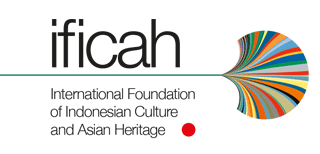Mandau
| Object | Mandau “gayang”, “duku”, “simpul” |
| Culture | Borneo/Sarawak, West-, Dayak, Kadazan (Kenyah?) |
| Time | 19th century |
| Dimensions | Length 64 cm |
| Material | Steel, stag horn, rattan, goat hair, wood, beads, textile, palm leaf |
Sword forms of this kind, called gayang, were considered typical for “Dusun” in former times. However, “Dusun” (today Kadazan) is not a precise term for an ethnic group, but rather a term coined by Islamic coastal Malays for the dayak plantation farmers in the mountainous hinterland of Sabah near the coast. Local rulers in Sabah and Sarawak, which can also be regarded as belonging to the Kenyah-Dayak (the ethnic boundaries are fluid and depend primarily on geographical conditions, i.e. river courses – were attractive trading partners for Malay and Chinese, as they could supply highly paid forest products such as precious woods, precious stones from the rivers, gutta-percha, certain bird nests, etc.).
There are a number of significant differences between gayang, the sword of the Dusun groups, and mandau, which is mainly used by the Kayan and Kenyah groups. The gayang has a symmetrical biconvex cross section (in our case with a double pit cut in the upper half of the blade flank), while the typical mandau has a characteristic asymmetrical blade cross section (“chisel-grind”), which is or can be an advantage in woodworking. Our example also has a decorative forged texture with a forged hardened steel core layer, which was achieved by notch filing and subsequent flat forging (selective layer cutting). It has the typical double stepped back of a mandau. The slightly curved blade profile is typical for mandau of the Kenyah in Sarawak, whose blade tradition is partly determined by coastal Malaysian influences (via Iban-Dayak). Our piece is atypical for an Iban blade, and with Iban (and Kenyah) the pamor forging technique is completely unknown. The details of the iron cut on the “choir” and the blade base would be quite Kenyah-typical, but on the whole the production technique suggests a Malay work, possibly made in the Banjar area, but clearly designed for dayak needs and not Malay in habit. Cross-section, pamor and pit cut indicate Sumatran influenced forging traditions in Banjar, the form is “Kenyah-style”. The mystery cannot be completely deciphered, but a migration of qualified Malay smiths within the coastal sultanates along Borneo can be assumed. The fine ornamental grooves on the ricasso are also an element that indicates a Banjar-determined production. The rolled up extensions at the base of the blade or the ricasso, which mutated to krowit on Iban swords, are supposed to symbolise male sexual organs, but more likely this is a reminiscence of gaja, the stately elephant (as in keris).
The shape of the antlers-handle, which is braided with fine rattan at the handle and set on the blade-rod with especially fine damar resin, is typical for Sabah and Sarawak. It continues the Kajan and Kenyah handles, but has a more voluminous, compressed form with a high “crown”. The quality of the carving, which covers the pommel surface (main aso), is superbly executed, but somewhat “schematised” – it has the appearance of professional craftsmanship, probably in courtly surroundings (of a coastal sultanate). It is composed of suspended spirals, the typical Sarawak-style four-part whirls of “leeches” (lemetak) and individual leeches, which are probably originally a modified rudiment of Zhou and Han Chinese decorations in the “animal fighting style”. Among the Iban, it is said to symbolise headhunting because of its association with blood, but it is more likely to be linked to the claws and teeth of ancient Chinese and inner-Asian totem deities (tiger masks, taotie) and dragons (lung), which claimed human sacrifices and ensured agricultural fertility. The handle still clearly shows the original arrangement of an aso (dragon-like mythical creature or an aquatic fertility deity, dragon or crocodile) as the main motif (the finger-side extension) and the “human” arranged on it – recognisable by the two “limbs”. This “horseman motif” is the basis for a large number of old-Austronesian grip forms and motif groups. The human figure, which can only be recognised here by the vertebrae of the eyes and limbs, is possibly a representation of an initiator who symbolically traces the path to the world of the dead and back, which is tantamount to reminiscing a primordial process of creation and killing. The double spiral is the path of the initiator, or the path of life energy in general. However, it should also be remembered that headhunting also includes elements in the sense of accompanying the dead, whereby it was assumed that a high-ranking ancestor, supported by the victim, would achieve beneficial effects for the descendants in the hereafter. According to Johnsson (1912), the heads hunted on the occasion of funerals were therefore formerly deposited in leaf wrappings on the coffin of the deceased, so that the soul of the dead would not see that it was not a slave or relative in the original sense of the sacrifice, but a stranger.
The mouth of the scabbard – like the handle – is decorated in a rather striking but excellently executed manner with the surya (sun) motif, stylised skulls and stylised limbs and the attached spiral. The skull calotte is also found on the scabbard foot. Five decorative rattan knots hold the scabbard together. The grip crown and sheath are decorated with red, white and black tufts of goat hair – an adaptation of the symbolic colours of the Hindu triad of gods, which embody the universal claim to power of the raja of Sarawak and Brunei and are also indicated by the star in the neck of the grip. The nyo (or tempesing), the long-handled knife in the palm leaf sheath on the back of the scabbard, exists only as a wooden dummy. The palm leaf sheath is covered with red fabric and covered with yellow-black bead embroidery with spiral motif.
Supplementing Literature Back to room view














